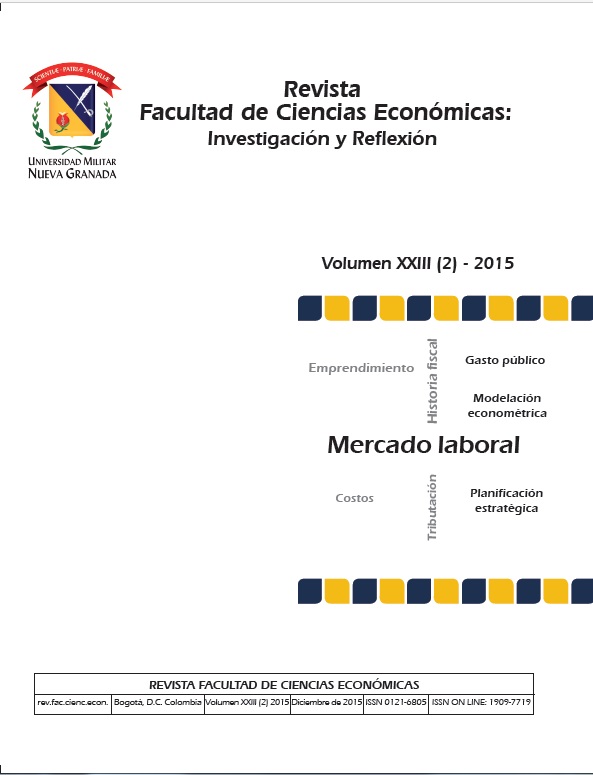Integral energy demand model management
Abstract
Energy management means optimizing one of the most complex and important technical creations that we know: the power system. There are a lot of methods for optimization of power generation and distribution. So the model of comprehensive energy demand (DSM) is a strategy to improve the energy system in the consumption side. It extends from energy policy, experimental economics, the theory of agents, improved energy efficiency through support and application software, intelligent power rates with incentives for certain consumption patterns to sophisticated control systems real-time distributed energy resources. This document provides an overview and a taxonomy for the development of a comprehensive systematic model of DSM, which analyzes the different elements of construction, and provides a perspective of how to use a model of process hierarchical analysis and blurred comprehensive evaluation for implementationDownloads
References
Boyle, S. (1996). DSM progress and lessons in the global context. Energy Policy, 24(4), 345–359. doi:10.1016/0301-4215(95)00142-5
Brañas-Garza, P., & Espinosa, M. P. (2011). Experimental and economy behavior. Papeles Del Psicologo, 32(2), 185–193.
Chen, H., Wang, X., Wang, X. & Chen, H. (2004). Design, implementation and application of a Java-based platform for electricity market auction experiments. Dianli Xitong Zidonghua/Automation of Electric Power Systems, 28(17), 22–26, 44.
Boyle, S. (1996). DSM progress and lessons in the global context. Energy Policy, 24(4), 345–359. doi:10.1016/0301-4215(95)00142-5
Brañas-Garza, P., & Espinosa, M. P. (2011). Experimental and economy behavior. Papeles Del Psicologo, 32(2), 185–193.
Chen, H., Wang, X., Wang, X. & Chen, H. (2004). Design, implementation and application of a Java-based platform for electricity market auction experiments. Dianli Xitong Zidonghua/Automation of Electric Power Systems, 28(17), 22–26, 44.
Elshkaki, A., Van Der Voet, E., Van Holderbeke, M. & Timmermans, V. (2004). The environmental and economic consequences of the developments of lead stocks in the Dutch economic system. Resources, Conservation and Recycling, 42(2), 133–154.
doi:10.1016/j.resconrec.2004.02.008
Gu, D., Liang, C., Zhong, J., Wang, J., Lu, W., Song, J. & Wu, Y. (2012). Intelligent information acquisition and utilization in safety evaluation decision making process of power generation enterprises (Vol. 102 LNBIP).
Hamdan, H. A., Ghajar, R. F. & Chedid, R. B. (2012). A simulation model for reliability-based appraisal of an energy policy: The case of Lebanon. Energy Policy, 45, 293–303. doi:10.1016/j.enpol.2012.02.034
Han, Y., Su, G., Yuan, H. & Wang, W. (2010). A collaborative early warning method of transportation during snow disaster based on fuzzy comprehensive evaluation. En Proceedings - 2010 7th International Conference on Fuzzy Systems and Knowledge Discovery, FSKD 2010 (Vol. 2, pp. 945–951). doi:10.1109/FSKD.2010.5569141
Huang, J., Xue, Y., Wen, F., Xu, J., Xue, F., & Dong, Z. (2011). A review of power market simulation platform. Dianli Xitong Zidonghua/Automation of Electric Power Systems, 35(9), 6–13, 35.
Li, Q., Lin, P. & Hu, Y. (2013). Innovation and application of scientific research strategy to super high arch dam. Shuili Fadian Xuebao/Journal of Hydroelectric Engineering, 32(5), 281–287.
Räsänen, M., Ruusunen, J., & Hämäläinen, R. P. (1995). Customer level analysis of dynamic pricing experiments using consumption-pattern models. Energy, 20(9), 897–906.
Schlenzig, C. (1998). Energy planning and environmental management with the information and decision support system MESAP. International Journal of Global Energy Issues, 12(1-6), 81–91.
Wei, Y.-M. & Liang, Q.-M. (2009). A new approach to energy modelling: The se3T system and its multi-objective integrated methodology. International Journal of Global Energy Issues, 31(1), 88–109. doi:10.1504/IJGEI.2009.021544
Zou, B., Li, Q.-H. & Yan, M.-S. (2005). Agent-based simulation model on pool-based electricity market using locational marginal price. Zhongguo Dianji Gongcheng Xuebao/Proceedings of the Chinese Society of Electrical Engineering, 25(15), 7–11.











